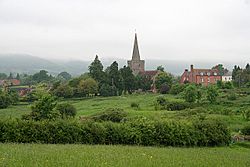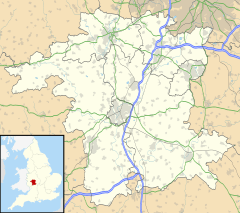Castlemorton facts for kids
Quick facts for kids Castlemorton |
|
|---|---|
 |
|
| Population | 617 (2021 census) |
| District |
|
| Shire county | |
| Region | |
| Country | England |
| Sovereign state | United Kingdom |
| Post town | Malvern |
| Postcode district | WR13 |
| Police | West Mercia |
| Fire | Hereford and Worcester |
| Ambulance | West Midlands |
| EU Parliament | West Midlands |
Castlemorton is a village and civil parish in England. It is located near Malvern in the Malvern Hills District. This area is part of the county of Worcestershire. The village includes a main center, a large open area called a common, and many farms and houses.
In 2013, the Worcestershire Wildlife Trust bought 42 acres of meadow land. This land was at Hollybed Farm. The purchase was part of a project to celebrate a special event. It marked the 60th Anniversary of the Coronation of Elizabeth II. The plan was to restore these meadows and create a new nature reserve.
In 1992, Castlemorton Common was the site of a very large event. It was a week-long free music festival. This event attracted many people and became well-known. It even made national news headlines across the country.
The 2015 World War II film Our Father was filmed here. Parts of the movie were shot on Castlemorton Common.
History of Castlemorton
A very old castle once stood south of the village. It was a motte-and-bailey castle. This type of castle had a mound of earth (motte) with a tower. It also had a walled courtyard (bailey). You can still see the earthwork remains of this castle today.
The Malvern Chase and Castlemorton Common
Castlemorton Common was once part of a huge royal hunting area. This area was known as the Malvern Chase. King James I later divided much of this hunting land. Examples include the Eastnor Castle Estate. Castlemorton Common is the largest part that remains. It is still open public land, meaning it is not fenced off.
Today, much of Castlemorton is a special protected area. It is called an Area of Outstanding Natural Beauty. It is also a Site of Special Scientific Interest (SSSI). This protection is because of the rare animals and plants that live there.


